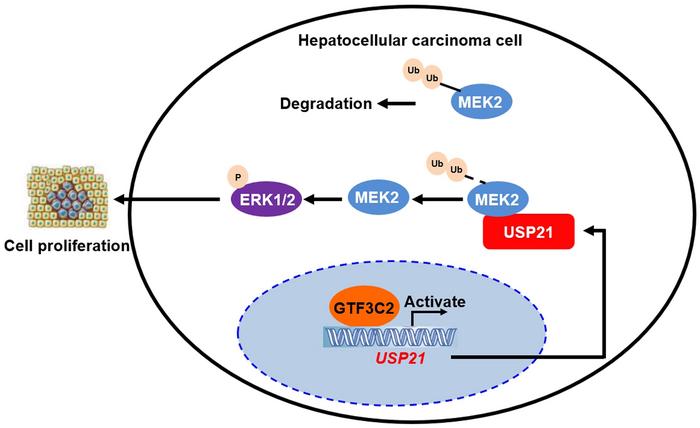In the ever-evolving landscape of cancer research, particularly in the realm of hepatocellular carcinoma (HCC), a recent study has unveiled significant findings regarding the role of a protein known as General Transcription Factor IIIC Subunit 2 (GTF3C2). This protein has garnered attention due to its potential implications in cell proliferation, a critical factor in cancer development and progression. The study meticulously investigates the expression of GTF3C2, unearthing its function and the intricate molecular mechanisms through which it operates within HCC cells. The research endeavors to clarify the enigmatic association between GTF3C2 and the advancement of liver cancer, presenting new avenues for therapeutic interventions.
GTF3C2, a component of the transcription machinery specifically linked to RNA polymerase III, is primarily known for regulating various genes involved in cellular growth and differentiation. The study showcased that GTF3C2 expression is notably elevated in HCC tissues when juxtaposed with non-tumor counterparts, thereby hinting at its potential oncogenic role. Detailed analyses revealed a correlation between heightened GTF3C2 levels and the advancement of tumor stages, suggesting that this protein may serve as a biomarker for HCC prognosis. Such findings are pivotal, as they not only enhance our understanding of the molecular underpinnings of liver cancer but also present novel targets for clinical applications.
Through a combination of public database analyses and clinical sample assessments, researchers employed robust methodologies, including reverse transcription-quantitative polymerase chain reaction and Western blot assays, to quantify the expression of GTF3C2 in HCC. These techniques provided a solid foundation for their conclusions, emphasizing GTF3C2’s role in cancer cell proliferation. The study also examined the interaction between GTF3C2 and other significant proteins, particularly focusing on Ubiquitin Specific Peptidase 21 (USP21), Mitogen-Activated Protein Kinase 2 (MEK2), and Extracellular Signal-Regulated Kinases 1/2 (ERK1/2). Elucidating these interactions is crucial, as it provides insights into the signaling pathways that GTF3C2 activates, further contributing to the malignant characteristics of HCC.
The experimental framework involved both in vitro and in vivo analyses. By employing various assays, including the Cell Counting Kit-8 and colony formation assays, the researchers meticulously demonstrated the proliferative impact of GTF3C2 on HCC cell lines. This multifaceted approach not only confirmed that GTF3C2 drives the proliferation of hepatic cancer cells but also highlighted the importance of USP21 in mediating this effect. The study notably established that GTF3C2 enhances the transcriptional activity of USP21, subsequently leading to increased levels of MEK2 and phosphorylated ERK1/2. This cascade of reactions positions GTF3C2 as a critical player in HCC progression, fundamentally altering the landscape of our understandings of liver cancer biology.
Furthermore, the use of HCC cell xenografts in nude mice models allowed researchers to validate their in vitro findings within a living organism. The in vivo results corroborated that GTF3C2 not only promotes tumor cell proliferation in a controlled setting but also fosters tumor growth in a biological context. Such findings underline the translational potential of targeting GTF3C2 for therapeutic interventions, suggesting a potential shift in treatment paradigms for HCC.
The study culminates in a significant conclusion that GTF3C2 is not merely a passive player but rather an active mediator in HCC development. GTF3C2’s engagement with the USP21/MEK2/ERK1/2 signaling pathway elucidates a previously unrecognized molecular mechanism that propels HCC progression. This revelation is especially crucial in a field where understanding the intricate signaling networks is essential for developing effective therapies.
As research progresses, the implications of targeting GTF3C2 cannot be overstated. By deciphering the molecular pathways influenced by GTF3C2, therapeutic strategies can be tailored to inhibit its oncogenic effects, thereby improving patient outcomes. The study serves as a beacon for future research efforts aimed at exploring the therapeutic potential of GTF3C2 inhibition in HCC, advocating for more extensive clinical trials to evaluate the feasibility of such approaches.
The publication of these findings in the reputable Journal of Clinical and Translational Hepatology further amplifies their significance. This journal is dedicated to advancing our understanding of liver diseases, ensuring that critical studies like this reach a wide audience within the scientific community. As awareness of GTF3C2’s role in HCC expands, it is anticipated that ongoing research will continue to unravel the complexities surrounding liver cancer and foster innovative treatment strategies.
In summary, the elevation of GTF3C2 in hepatocellular carcinoma highlights its potential as both a prognostic marker and a therapeutic target. This pivotal study provides a comprehensive overview of GTF3C2’s actions within HCC, emphasizing the importance of further research into this critical area of cancer biology. As clinicians and researchers alike digest these findings, the hope is that they will catalyze the development of targeted therapies that can challenge the status quo of HCC treatment and improve survival outcomes for patients afflicted by this aggressive form of cancer.
Subject of Research: GTF3C2 in Hepatocellular Carcinoma
Article Title: GTF3C2 Promotes the Proliferation of Hepatocellular Carcinoma Cells through the USP21/MEK2/ERK1/2 Pathway
News Publication Date: 11-Feb-2025
Web References: Journal of Clinical and Translational Hepatology
References: DOI: 10.14218/JCTH.2024.00386
Image Credits: Credit: Kangsheng Tu, Dongsheng Huang, Yani Wu, Yingnan Yang
Keywords: Hepatocellular carcinoma, Cell proliferation, Scientific publishing, Liver tumors, Cellular regulation.
Tags: cancer research advancementscell proliferation mechanisms in liver cancerelevated GTF3C2 expression in tumorsGTF3C2 and RNA polymerase III regulationGTF3C2 in hepatocellular carcinomaliver cancer biomarkersliver cancer prognosis factorsmolecular mechanisms of HCC progressiononcogenic roles of GTF3C2therapeutic interventions for HCCtranscription factors in cancerUSP21 MEK2 ERK1/2 signaling pathway





